Related Research Articles

Delta Crucis or δ Crucis, also identified as Imai, is a star in the southern constellation of Crux, and is the faintest of the four bright stars that form the prominent asterism known as the Southern Cross. This star has an apparent magnitude of 2.8, and its proper name was adopted by the International Astronomical Union on 10 August 2018. Imai is a massive, hot and rapidly rotating star that is in the process of evolving into a giant, and is located at a distance of about 345 light-years from the Sun.
Omicron Scorpii is a star in the zodiac constellation of Scorpius. With an apparent visual magnitude of +4.57, it is visible to the naked eye. Parallax measurements indicate a distance of roughly 900 light years. It is located in the proximity of the Rho Ophiuchi dark cloud.
HD 70930 is a binary star system in the southern constellation of Vela. It has the Bayer designation B Velorum, while HD 70930 is the star's identifier in the Henry Draper catalogue. With a combined apparent visual magnitude of 4.79, it is visible to the naked eye as a faint point of light. The distance to this system is approximately 1,700 light years based on parallax, and it has an absolute magnitude of −3.74. It is drifting further away from the Sun with a radial velocity of about +27 km/s. The system is a member of the Vel OB2 association of co-moving stars.

Tau1 Arietis, Latinized from τ1 Arietis, is the Bayer designation for a triple star system in the northern constellation of Aries. Based upon an annual parallax shift of 6.1786 mas, it is approximately 530 light-years distant from Earth. The combined apparent visual magnitude is 5.27, making it faintly visible to the naked eye.
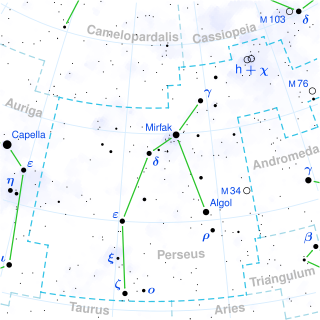
Zeta Persei is a star in the northern constellation of Perseus. With an apparent visual magnitude of 2.9, it can be readily seen with the naked eye. Parallax measurements place it at a distance of about 750 light-years from Earth.

Epsilon Centauri is a star in the southern constellation of Centaurus. It is one of the brightest stars in the constellation with a slightly variable apparent visual magnitude of +2.30. Parallax measurements put it at a distance of around 430 light-years from Earth.
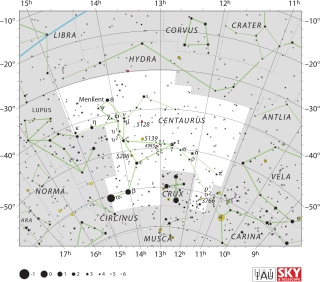
Delta Centauri, Latinized from δ Centauri, is a star in the southern constellation of Centaurus. The apparent visual magnitude of this star is +2.57, making it readily visible to the naked eye. Based upon parallax measurements, it is located at a distance of about 410 light-years from the Earth. The star is drifting further away with a radial velocity of +11 km/s.

Rho Centauri, Latinized from ρ Centauri, is a binary star system in the southern constellation of Centaurus. It is visible to the naked eye as a blue-white hued point of light with a combined apparent visual magnitude of +3.97. The system is located approximately 276 light years from the Sun based on parallax, and is drifting further away with a radial velocity of around +15 km/s. It is a proper motion member of the Lower Centaurus–Crux sub-group in the Scorpius–Centaurus OB association, the nearest such association of co-moving massive stars to the Sun.
HD 102776, also known by its Bayer designation j Centauri, is a suspected astrometric binary star system in the southern constellation of Centaurus. It has a blue-white hue and is faintly visible to the naked eye with a typical apparent visual magnitude of 4.30. The distance to this star is approximately 600 light years based on parallax, and it is drifting further away with a radial velocity of ~29 km/s. It is a member of the Lower Centaurus Crux subgroup of the Sco OB2 association. HD 102776 has a relatively large peculiar velocity of 31.1 km/s and is a candidate runaway star that was ejected from its association, most likely by a supernova explosion.
Chi Centauri is a star in the constellation Centaurus.
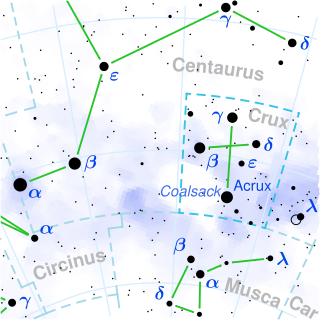
λ Crucis, Latinized as Lambda Crucis, is a single, variable star in the southern constellation Crux, near the constellation border with Centaurus. It is visible to the naked eye as a faint, blue-white hued point of light with an apparent visual magnitude that fluctuates around 4.62. The star is located approximately 384 light-years distant from the Sun based on parallax, and is drifting further away with a radial velocity of +12 km/s. It is a proper motion member of the Lower Centaurus–Crux sub-group in the Scorpius–Centaurus OB association, the nearest such association of co-moving massive stars to the Sun.
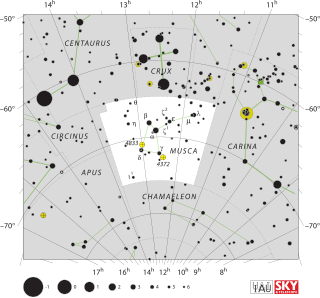
Alpha Muscae, Latinized from α Muscae, is a star in the southern circumpolar constellation of Musca. With an apparent visual magnitude of +2.7, it is the brightest star in the constellation. The distance to this star has been determined using parallax measurements, giving an estimate of about 315 light-years from Earth.

DL Crucis is a variable star in the constellation Crux.

CH Crucis is a solitary variable star in the southern constellation of Crux. It has the Gould designation 35 G. Crucis. The object is visible to the naked eye as a faint, blue-white hued point of light with an apparent visual magnitude that fluctuates around 4.91. The star is located approximately 780 light years distant from the Sun based on parallax, and is drifting further away with a radial velocity of about +12.5 km/s. It is a member of the nearby Sco OB2 association.
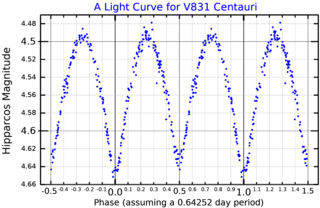
V831 Centauri is a multiple star system in the constellation Centaurus. It is visible to the naked eye with an apparent visual magnitude that ranges from 4.49 down to 4.66. The system is located at a distance of approximately 380 light years from the Sun based on parallax, and is drifting further away with a radial velocity of +12 km/s. It is a likely member of the Lower Centaurus Crux concentration of the Sco OB2 association of co-moving stars.

HD 110956 is a single star in the southern constellation of Crux. It is faintly visible to the naked eye with an apparent visual magnitude of 4.62. The distance to this star is approximately 385 light years based on parallax and it is drifting further away with a radial velocity of 15.5 km/s. It is a probable member of the Lower Centaurus–Crux subgroup of the Scorpius–Centaurus association.
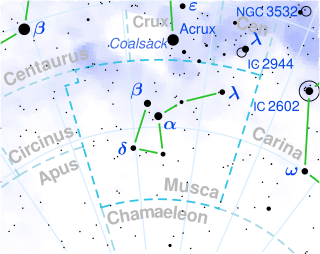
HD 103079 is a class B4V star in the constellation Musca. Its apparent magnitude is 4.89 and it is approximately 362 light years away from Earth based on parallax. It is a member of the Lower Centaurus–Crux subgroup of the Scorpius–Centaurus association, a group of predominantly hot blue-white stars that share a common origin and proper motion across the galaxy.

V1073 Scorpii is a variable star in the constellation Scorpius. It has a non-Greek Bayer designation of k Scorpii. The star has a blue-white hue and is visible to the naked eye with an apparent visual magnitude that fluctuates around +4.87. Parallax measurements yield a distance estimate of approximately 2,920 ly (896 pc) from the Sun, and it is drifting further away with a radial velocity of +7 km/s. It has an absolute magnitude of −6.8
Zeta2 Muscae, Latinized from ζ2 Muscae, is a star in the southern constellation of Musca. Its apparent magnitude is 5.16. This is a white main sequence star of spectral type A5V around 330 light-years distant from Earth. Like several other stars in the constellation, it is a member of the Lower Centaurus–Crux subgroup of the Scorpius–Centaurus association, a group of predominantly hot blue-white stars that share a common origin and proper motion across the galaxy. It is part of a triple star system with faint companions at 0.5 and 32.4 arc seconds distance. The former is an infrared source, the latter has a visual magnitude of 10.7.
References
- ESA (1997). "The Hipparcos and Tycho Catalogues" . Retrieved 2006-12-26.
- Kostjuk, N. D. (2002). "HD-DM-GC-HR-HIP-Bayer-Flamsteed Cross Index" . Retrieved 2006-12-26.
- Roman, N. G. (1987). "Identification of a Constellation from a Position" . Retrieved 2006-12-26.
- "SIMBAD Astronomical Database". Centre de Données astronomiques de Strasbourg. Retrieved 2007-01-02.
- Samus, N. N.; Durlevich, O. V.; et al. (2004). "Combined General Catalogue of Variable Stars (GCVS4.2)" . Retrieved 2007-01-03.
- Gould, B. A. "Uranometria Argentina". Reprinted and updated by Pilcher, F. Archived from the original on 2012-02-27. Retrieved 2010-07-19.
- "AAVSO Website". American Association of Variable Star Observers. Retrieved 9 March 2014.
- "Naming Stars" . Retrieved 13 December 2017.